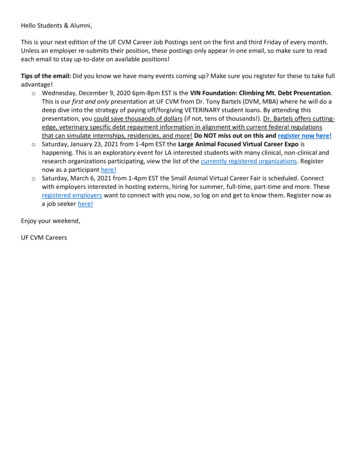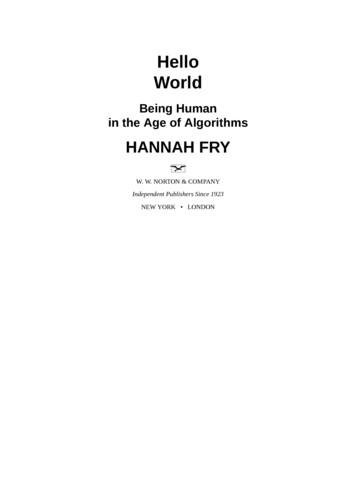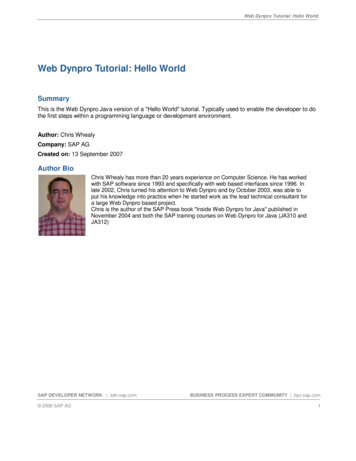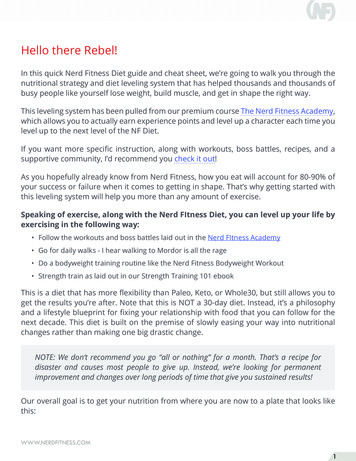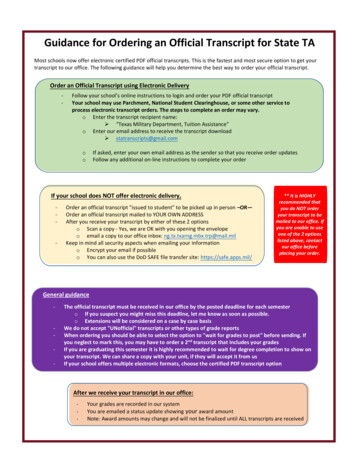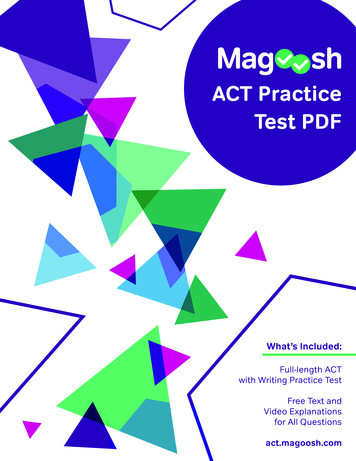
Transcription
Hello!What You’ll Need to Take the Test: A pencil A timer Try the Study Timer: Test Prep Stopwatch byMagoosh (iOS app), which has an ACT Practice Testsetting to help you manage your time. An answer sheet to record your answers You will find an answer sheet on the last page of thisPDF. Print it out so that you can practice bubblingyour answers, as you will on test day. One page of scratch paper to plan your essay for yourWriting test response On test day, you will receive a test booklet with spaceto plan your essay. Four pages of lined paper for the Writing test On test day, you will receive a test booklet with fourlined pages on which to write your essay.Welcome to an important step in your ACT prep! This fulllength ACT Practice Test PDF contains 216 of Magoosh’shighest-quality, student-tested practice questions. Takenfrom our premium online ACT Prep, these questions havebeen adapted to mimic the official ACT exam that you willencounter on test day.with one key difference.What’s the difference? Well, at the end of this PDF, youwill find an answer key and a guide to grading your practice test. That’s pretty normal. But, you will also find alink to text and video explanations that show you howto solve every single question in this practice test.In these video explanations, our ACT experts walk youthrough each question step-by-step. They explain: Which concept the question or problem is testing. Which strategies you can use to answer the questionquickly and correctly. Which answer choices are trying to trick you (and howto avoid those traps!)You sure won’t find that in an ACT book!Practice Test Tips If you’d like to use this practice test as part of your studyschedule, you can substitute it for one of the practicetests in our ACT Study Schedules here:One Week ACT Study ScheduleOne Month ACT Study ScheduleTwo Month ACT Study ScheduleThese video explanations help you take your ACT prepto the next level. Because it’s one thing to take a practicetest and call it a day—but if you can learn from your mistakes, then you’re setting yourself up to do better when itreally counts.Three Month ACT Study Schedule Set aside approximately four hours of uninterruptedtime to take the practice test. Try to take the entire practice test in one sitting. Give yourself a brief, ten-minute break after the Mathematics test. Give yourself a brief, five-minute break after the Sciencetest. Take the test in a quiet place where you won’t be distracted. Mimic test day conditions by turning off your phone andleaving it in another room. Use a countdown timer and remember to reset it foreach test. Eat a healthy, energizing snack before taking the practice test. After the test, check your answers and make note of anyquestions you missed. Watch the explanation video for every question you getwrong, so that you don’t repeat the same mistakes ontest day! Visit act.magoosh.com to sign up for Magoosh ACTPrep and gain access to more practice questions.Let’s Get StartedTaking a timed, full-length practice test is one of the bestways to prepare yourself for the real ACT. Mimickingtest-like conditions will help improve your stamina, pacing, and understanding of your personal strengths andweaknesses.While you may choose to take this test online (and savesome trees while you’re at it), remember that the officialACT exam is paper-based. We’ve made this PDF printableso that you can print it out and take it like the officialexam if you want—it’s totally up to you!Here’s What to Expect on the Following Pages: A full-length ACT practice test with the optional Writingtest (aka “the essay”) An answer key Information on grading your test Links to text and video explanations for every singlequestionact.magoosh.comWant more tips and tricks?Read How to Take an ACT Practice Test.2Good luck!
11English Test45 Minutes —75 QuestionsINSTRUCTIONS: In the following five passages, you’ll find portions that have been underlined and numbered. The questionsin the right-hand column will present alternatives for the underlined words and phrases. Some questions will ask you to selectthe answer choice that best expresses the idea, makes thestatement appropriate for standard written English, or makesthe wording more consistent with the passage’s style and tone.If you think the original wording of the statement is the bestoption, select “NO CHANGE.” In other cases, you’ll be asked aquestion about the underlined text. You will need to choose thebest answer to the question.In addition, you will be asked questions about a portion ofthe passage or about the entire passage. In these cases,the questions do not refer to an underlined section of thepassage. Instead, they are identified by a number in a box.Choose the answer that you consider best and mark that onyour answer sheet. ACT recommends reading each passagethrough one time before answering any questions. Many ofthe questions will require you to read a few sentences aheadto find the answer. Make sure that you read far enough aheadbefore answering each question.PASSAGE IThe Lancashire WitchesAbout four hundred years ago, in 1612, NorthwestEngland was the scene of England’s largest peacetimewitch trial: the trial of the Lancashire witches. Twenty1people, mostly from the Pendle area of Lancashire,were imprisoned in the castle as witches. In the end, ten2were hanged, one died in jail, one was sentenced to thestockades,and eight were acquitted. [A] How did this1witch trial come about, and what accounts for its static3fame?We know so much about the Lancashire Witches because the trial was recorded in unique detail by the clerkof the court Thomas Potts who published his account1. A.B.C.D.NO CHANGEwitch trial andwitch trialwitch trial;2. A.B.C.D.NO CHANGEhad been imprisonedhave been imprisonedwere being imprisoned3. A.B.C.D.NO CHANGErobustenduringvigorous4. A.B.C.D.NO CHANGEcourt, Thomas Potts, who publishedcourt, Thomas Potts, who published,court Thomas Potts who published,5. A.B.C.D.NO CHANGEitsit’shis6. A.B.C.D.NO CHANGEevidence, but alsoevidence and additionallyevidence and7. A.B.C.D.NO CHANGEwas constructedwas being constructedwas constructing8. A.B.C.D.NO CHANGEyoung woman, Alizon Device, in a field nearyoung woman, Alizon Device in a field nearyoung woman Alizon Device, in a field, near4soon afterwards. Robert Poole recently published amodern-English edition of their book, together with an5essay piecing together what we know of the events of1612. [B] It reveals how Potts carefully edited theevidence, and also how the case against the “witches”6were constructed and manipulated to bring about a7spectacular show trial.It all began in mid-March when a peddler from Halifax named John Law had a frightening encounter witha poor young woman, Alizon Device in a field, near the8town of Colne. He refused her request for pins, and therewas a brief argument during which he was seized by afit that left him with “his head drawn awry, his eyes andact.magoosh.com3GO TO NEXT PAGE
11face deformed, his speech not well to be understood; histhighs and legs stark lame.” We can now recognize this as9. A.B.C.D.a stroke, perhaps triggered by the stressful encounter. [C]Alizon Device was sent for and surprised all by confessing to the bewitching of John Law, and then begged forforgiveness. [D]10. The quotation marks used in the preceding paragraph most likely indicate:910A.B.C.D.11. A.B.C.D.When Alizon Device was unable to cure the peddler the11local magistrate, Roger Nowell, was called in. “With weeping tears,” Alizon explained to Nowell that she had beenShould the writer make this addition here?Nowell quickly interviewed Alizon’sA. Yes, because it helps the reader understand thatold Demdike was an established member of theLancashire community.B. Yes, because it explains why Demdike and “oldChattox” were rivals.C. No, because it interrupts the discussion at thispoint in the paragraph.D. No, because it doesn’t explain why old Demdikewas accused of practicing witchcraft.grandmother and mother, as well as Demdike’s supposedrival, “old Chattox.” Their panicky attempts to explainthemselves and shift the blame to others eventually onlyended up incriminating them, and the four were sent toLancashire prison in early April to await trial at the summer courts.1314NO CHANGEpeddler, thepeddler; thepeddler: the“Old Demdike” had lived in the town for decades.in the district for her knowledge of old prayers, charms,12direct quotes from Alizon Device.direct quotes from John Law.words quoted from a published source.an ironic tone of the author.12. At this point, the writer wishes to add the followingsentence:led astray by her grandmother, “old Demdike,” well-knowncures, and curses.NO CHANGEJohn Law and she then beggedJohn Law and beggingJohn Law and begged15Adapted from Poole, R. “The Lancashire Witches, 1612-2012.”Questions 13 - 15 ask about the precedingpassage as a whole.The Public Domain Review.13. Given that all of the choices are true, which one mosteffectively concludes the essay?A. The trials of the four women were soon followedby the court appearances of sixteen other accused witches, setting the stage for numerousother witch trials of the 17th century.B. While the women were in prison, they reportedly still practiced witchcraft with the other eightwomen imprisoned after them.C. Despite the women’s ill-gotten fate, early17th-century England was continually plaguedwith witchcraft well into the 18th century.D. These four women, however, would set the standard for fair trials for those accused of witchcraftin the rest of the seventeenth century.act.magoosh.com4GO TO NEXT PAGE
1114. The writer is considering deleting the word “panicky”in the final sentence of the last paragraph. Should theword be kept or deleted?15. The writer is considering adding the following sentence to the essay:Before modern medicine, however, such an occurrencewas often interpreted as magic or witchcraft.A. Kept, because it helps indicate why the women’sdefense of themselves lacked strength.B. Kept, because it provides evidence that the women were guilty of their accused crimes.C. Deleted, because it reiterates information alreadystated in the previous sentence.D. Deleted, because the word provides unnecessarydescriptive details.If the sentence were added, it would most logically beplaced at Point:A.B.C.D.ABCDPASSAGE IIWriting a Personal Essay[1]Acclaimed novelist, Toni Morrison, likens memory to the16way the Mississippi River, and other rivers like it, yearsafter being straightened and pushed into levees by theArmy Corps of Engineers, still strain at times to flood its17banks and revisit the original, meandering route. “All water has a perfect memory and is forever trying to get backto where it was,” Morrison tells us, “Writers are like, that18remember where we were, what valley we ran through,what the banks were like, the light that was there, and the16. A.B.C.D.NO CHANGEnovelist, Toni Morrisonnovelist Toni Morrisonnovelist Toni Morrison,17. A.B.C.D.NO CHANGEstrainsstrainedstraining18. A.B.C.D.NO CHANGEare like that. Weare like that, weare like that. With us19. A.B.C.D.NO CHANGEworry that inconsistent memoryare worried and think that their memoryworry their memory20. A.B.C.D.NO CHANGEhas provenhad provedproved21. A.B.C.D.NO CHANGEIt being my experience, most of usIn my experience, most of usIt was my experience that most of usroute back to our original place.”[2]I have worked with so many writers who worry their in19consistent memory is not sharp enough, exact enough, or19reliable enough for them to capture childhood momentswith any authority, and, of course, science had proven the20fallibility of memory time and time again. [A] But what canwe do, as writers?[3]It has been my experience that most of us remember21more than we think that we do. [B] It just takes some timeto stop, think, and take our minds back to the originalriverbanks.act.magoosh.com5GO TO NEXT PAGE
11Once we have latched onto one of them—the color of the22tablecloth on Aunt Jean’s holiday table and the old fashioned centerpiece she inherited from her grandmother,perhaps—that tiny, small foothold of memory can often23help to unloosen yet another, and then another, smalldetail. [C] These past moments are in your mind still, Morrison is telling us, waiting for us to uncover the momentsNO CHANGEmemoryof itof those riverbanks23. A.B.C.D.NO CHANGEperhaps, that tiny smallperhaps that tiny, smallperhaps—that small24. Which choice most strongly maintains the imageryused repeatedly in this essay?24we have since forgotten. Bringing it to the front just takestime.22. A.B.C.D.24A. NO CHANGEB. and it is up to us, as writers, to learn how to recover what they have to say.C. just as the past lives in the memory of a river.D. allowing us to remember childhood events insignificant detail.[4]In the end, all we promise the reader is that we have25done our absolute best to fact-check our memories, and26that we have tried our hardest to be accurate. [D] Smart26readers know that no other guarantee is necessary orpossible.[5]So, go to the river of memory.25. A.B.C.D.NO CHANGEAdditionally,However,As a result,26. A.B.C.D.NO CHANGEmemories and that wememories and wememories, and that we, as writers,27. If the writer were to delete the previous sentence, theparagraph would primarily lose:27A. imagery that is used to connect the reader backto a previous idea.B. a suggestion that readers should sit by riverswhen remembering their past.C. an unnecessary detail that contradicts information presented earlier in the paragraph.D. a description that explains how memory andrivers are connected.Find one small detail, and start writing for just ten min2828. A.B.C.D.utes, trying to remember one small detail at a time. Seewhere it takes you today.NO CHANGEsmall moment and,moment andof these rivers andAdapted from Moore, D. W. Crafting the Personal Essay: A Guide forWriting and Publishing Creative Non-Fiction. Cincinnati, OH: Writer’sDiges
Magoosh (iOS app), which has an ACT Practice Test setting to help you manage your time. An answer sheet to record your answers You will find an answer sheet on the last page of this PDF. Print it out so that you can practice bubbling your answers, as you will on test day. One page of scratch paper to plan your essay for yourFile Size: 2MBPage Count: 55

